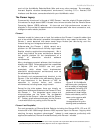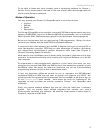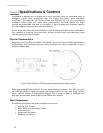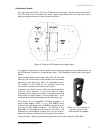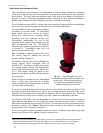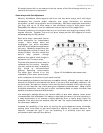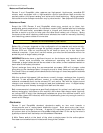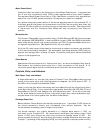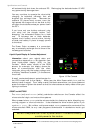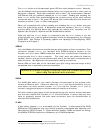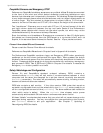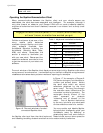ActivMedia Robotics
Motor-Power Board
Inside the robot, mounted to the battery box, is the Motor-Power board. It supplies both
the 12 and five volts direct-current (VDC) power requirements of your robot’s systems.
The standard Motor-Power board has a 12-pin User-Power connector that supports four
sets of five- and 12-VDC power ports (total 1.5 ampere) for custom accessories.
An optional computer-power section to the board supplies power for the onboard PC. It
includes a special low-power and power-down circuit that lets you gently shut down the
onboard PC without direct connection through a keyboard or monitor. (See Appendix B
in this manual and the Computer Tech Notes that may accompany your robot for
details.)
Microcontroller
The Pioneer 2/PeopleBot microcontroller has a 20 MHz Siemens 88C166 microprocessor
with integrated 32K FLASH-ROM. It also has 32K of dynamic RAM, two RS232-compatible
serial ports, several digital and analog-to-digital, and PSU I/O user-accessible ports, and
an eight-bit expansion bus. (See Appendix A for I/O port details.)
All of the I/O ports, except those used for the motors, encoders, and sonar, are available
to the user for accessory hardware. The embedded operating software (P2OS) lets you
support and manage each of these I/O ports. Connector pinouts and electronics details
appear in the Appendices.
Sonar Boards
Associated with each sonar arrayforward and rearis a sonar multiplexer/firing board.
Wire leads to the individual sonar plug into a 16-pin connector on the board. A 10-
conductor power/signal cable connects the sonar board with the microcontroller.
Controls, Ports, and Indicators
Main Power, Fuse, and Indicator
A single slide-switch on the rear left panel of Pioneer 2 and PeopleBot robots controls
power to the entire robot and all its integrated accessories. Up is ON; down is OFF. A
red LED on the Console indicates Main Power.
Inside, on the top right side of the battery box (accessible through the hinged back door)
is the Main Power Fuse. It is an automotive-type (spade terminals) 15A (DX, DXe, CE, and
PeopleBots) or 20A (AT) fuse designed for tool-less replacement. To the left of the fuse,
on the same battery connection board, is the main power relay, which isolates the high-
ampere draw of the robot system from the Main Power Switch.
Recharge/Power Port
Below the Main Power Switch is the battery recharger port. It provides 12 VDC power to
the robot's electronics, motors, and accessories, even without batteries. Use the
recommended accessory power charger or equivalent.
You should maintain your robot’s batteries in a charged state above 11 VDC, as
indicated on the Console LCD. We recommend recharging the battery when it falls
below 11 VDC, even though the robot may continue to operate below 10 VDC. The
microcontroller will sound a warning when the battery voltage falls below that level (see
Chapter 7, Updating & Reconfiguring P2OS), and the optional computer power circuitry
15



